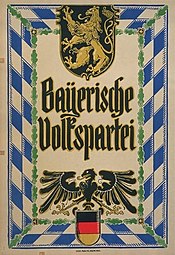Bavarian People's Party
This article has multiple issues. Please help improve it or discuss these issues on the talk page. (Learn how and when to remove these messages)
|
Bavarian People's Party Bayerische Volkspartei | |
|---|---|
 | |
| President(s) | Karl Friedrich Speck[1] Fritz Schäffer[2] |
| Founded | December 1918 |
| Dissolved | 5 July 1933 |
| Split from | Centre Party |
| Succeeded by | Christian Social Union in Bavaria, Bavaria Party (not legal successors) |
| Headquarters | Munich, Germany |
| Paramilitary wing | Bayernwacht |
| Ideology | Political Catholicism Bavarian regionalism Christian democracy Conservatism (Germany)[3] |
| Political position | Centre-right[4] |
| Religion | Roman Catholicism |
| International affiliation | International Agrarian Bureau (from 1921) |
| Colours | Cyan White |
| Party flag | |
 | |
The Bavarian People's Party (German: Bayerische Volkspartei; BVP) was the Bavarian branch of the Centre Party, a lay Roman Catholic party, which broke off from the rest of the party in 1918 to pursue a more conservative and more Bavarian particularist course.
History
The party displayed monarchist leanings because many Bavarians had never accepted the overthrow of the House of Wittelsbach in 1918, and there was a period of near separatism in the early 1920s, culminating in Gustav von Kahr's unwillingness to abide by rulings from Berlin during the autumn crisis of 1923. This only came to an end with the shock of Adolf Hitler's Beer Hall Putsch. Following the establishment of a more stable situation throughout Germany, the party came around to a more moderate line under the leadership of Ministerpräsident Heinrich Held and party president Fritz Schäffer.

During the Weimar Republic, the BVP was consistently the most popular party in Bavaria and the party with the most seats in the Landtag of Bavaria.
In the second round of the 1925 German presidential election, the main contenders were Paul von Hindenburg and Wilhelm Marx. If either the BVP or the Communist Party (KPD), who put up Ernst Thälmann in the second round, had supported Marx, he would have become president instead of the elderly von Hindenburg, who died in 1934 and was succeeded by Hitler.[5]
The party may be seen as a precursor to the Christian Social Union in Bavaria (CSU), but alongside the CSU the Bavaria Party which has members elected to city councils in some Bavarian regions and the Bavarian Centre Party were also refounded after World War II and are explicitly claiming the historical heritage of the BVP.
Politicians
See list of Bavarian People's Party politicians
References
- ^ (1918–1929)
- ^ (1929–1933)
- ^ Stibbe, Matthew (2010). Germany, 1914-1933: Politics, Society and Culture. Pearson Education. p. 79.
- ^ Stibbe, Matthew (2010). Germany, 1914-1933: Politics, Society and Culture. Pearson Education. p. 59.
- ^ Richard J. Evans (2003). The Coming of the Third Reich. Allen Lane, London. p. 82. ISBN 0-7139-9648-X.
External links
- 1933 disestablishments in Germany
- 1919 establishments in Germany
- Bavarian nationalism
- Christian democratic parties in Germany
- Conservative parties in Germany
- Defunct regional parties in Germany
- Nationalist parties in Germany
- Political parties disestablished in 1933
- Political parties established in 1919
- Political parties in the Weimar Republic
- Politics of Bavaria
- Catholic political parties
- Social conservative parties
